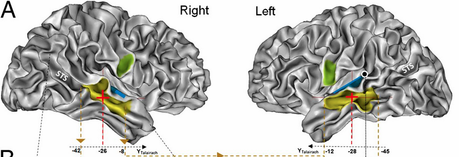The search for specifically human cortical landmarks has been frustrating. Reported asymmetries in the planum temporale and the inferior frontal region are not as robust as initially thought and also are observed, less marked, in other primates. Leroy et al. have now identified an asymmetry of the superior temporal sulcus (STS), at the core of our human communication and social cognition systems, that represents a species-specific perisylvian anatomical marker that is barely visible in chimpanzees. They suggest that focusing on gene expression relevant to this regions might shed light on the evolution of our crucial cognitive abilities. Here is their abstract and a figure from the paper:
Identifying potentially unique features of the human cerebral cortex is a first step to understanding how evolution has shaped the brain in our species. By analyzing MR images obtained from 177 humans and 73 chimpanzees, we observed a human-specific asymmetry in the superior temporal sulcus at the heart of the communication regions and which we have named the “superior temporal asymmetrical pit” (STAP). This 45-mm-long segment ventral to Heschl’s gyrus is deeper in the right hemisphere than in the left in 95% of typical human subjects, from infanthood till adulthood, and is present, irrespective of handedness, language lateralization, and sex although it is greater in males than in females. The STAP also is seen in several groups of atypical subjects including persons with situs inversus, autistic spectrum disorder, Turner syndrome, and corpus callosum agenesis. It is explained in part by the larger number of sulcal interruptions in the left than in the right hemisphere. Its early presence in the infants of this study as well as in fetuses and premature infants suggests a strong genetic influence. Because this asymmetry is barely visible in chimpanzees, we recommend the STAP region during midgestation as an important phenotype to investigate asymmetrical variations of gene expression among the primate lineage. This genetic target may provide important insights regarding the evolution of the crucial cognitive abilities sustained by this sulcus in our species, namely communication and social cognition.

Legend - Location of the STAP (yellow) relative to Heschl’s gyrus (blue) and the ventral tip of the central sulcus (green) on both left and right inner cortical surfaces of an individual adult brain. The STAP center is shown by a cross. The black dot with a white contour line shows the planum temporale landmark. (Click on figure to enlarge.)

